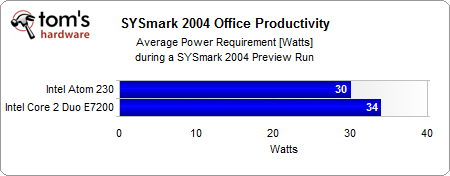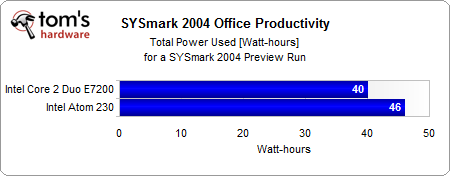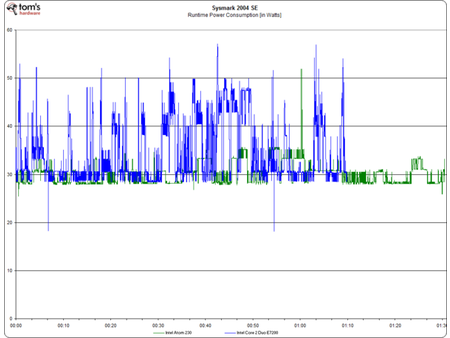Efficiency: Core 2 Nukes Atom On The Desktop
Efficiency and Performance per Watt

We calculated the average power requirements of the two systems during an entire SYSmark 2004 SE run. This reflects intensive use of the systems, using popular mainstream office and content creation applications. Surprisingly, the Core 2 Duo E7200 system required only slightly more power on average: 34 W vs. 30 W for the Atom 230.

We also tracked the total power both systems used to complete the SYSmark 2004 SE run measured in watt-hours. This metric gauges system performance per watt hour. Thanks to its faster performance, the Core 2 Duo E7200 system on the Foxconn G31 motherboard required 40 Wh to complete the entire benchmark, while the Atom machine, which is substantially slower, required 46 Wh and a much longer period of time (see diagram on the bottom of this page) to complete the workload. The Core 2 machine may require more power at peak loads, but less power for the specific workload. Expect the result to be more significant in favor of the Core 2 for processor-intensive workloads.

Finally, we calculated the SYSmark 2004 SE score per watt hour. The Atom 230 reached 2.2 SYSmark 2004 SE points per watt hour, while the Core 2 Duo machine did more than twice that: 5.65 points per watt hour. From an efficiency standpoint, the Core 2 Duo E7200 is vastly superior.
The diagram shows the system power consumption over the entire duration of the benchmark run, and it also shows how long the systems took to complete the workload. The Atom 230 took more than one hour and 30 minutes, while the Core 2 Duo system required one hour and 10 minutes. The Atom system usually didn’t exceed a 36 W maximum power requirement, but it continued to use power while the Core 2 system was finished. The power peaks of the Core 2 system were substantial, but they were exactly what you read: peaks. The 50+ W power consumption applies to only a fraction of the benchmark runtime.
Get Tom's Hardware's best news and in-depth reviews, straight to your inbox.
